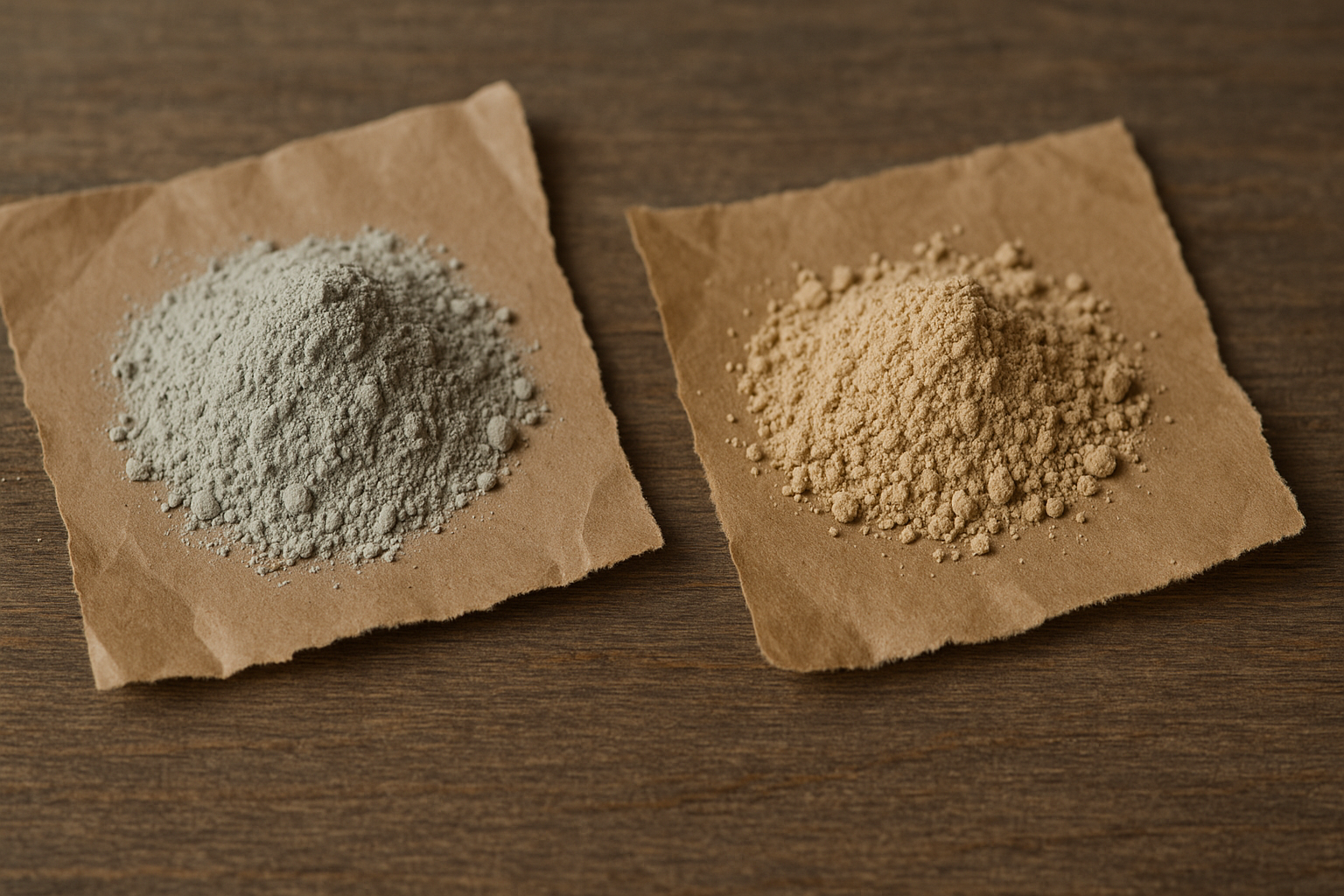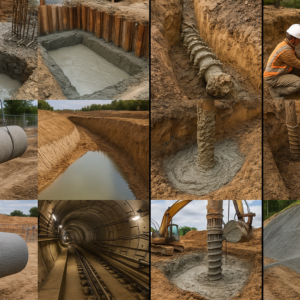The global shift toward sustainable manufacturing has put industrial minerals under environmental scrutiny. When comparing calcium bentonite vs paper bentonite, businesses want clear answers about which option creates less environmental harm. This comparison examines both materials through the lens of extraction methods, processing energy, carbon footprints, and long-term ecological impact.
Understanding Calcium Bentonite and Its Applications
Calcium bentonite is a naturally occurring clay mineral formed from volcanic ash weathering over millions of years. This non-swelling variety contains high concentrations of calcium ions rather than sodium. The material exhibits strong adsorption properties, making it useful across multiple sectors.
The clay has lower swelling potential compared to sodium varieties and does not form dense barriers when hydrated. This characteristic makes it suitable for agriculture, detoxification products, and industrial absorbents. CMS Industries specializes in both sodium and calcium bentonite grades, maintaining ISO 9001:2015 certification for quality control.
The mining process for calcium bentonite occurs through open-pit extraction methods. Workers remove overburden layers to access clay deposits beneath. This process requires careful land management and restoration planning.
What is Paper Bentonite?
Paper bentonite refers to specially processed bentonite clay used in paper manufacturing. The paper industry relies on this material as a retention aid, pitch control agent, and contaminant absorber. Manufacturers use bentonite in paper production and recycling processes, where it extends de-inking capabilities and aids in carbonless copy paper creation.
The material helps paper mills absorb wood resins that would otherwise interfere with machinery operation. Bentonite improves wet-end processing, absorbs contaminants, improves filler retention, and prevents sticky deposits, resulting in cleaner machine circuits.
Processing paper-grade bentonite requires additional refinement steps beyond standard mining operations. Manufacturers activate the clay through acid treatment or thermal processing to enhance its performance characteristics for paper applications.
Environmental Impact of Calcium Bentonite Mining
Mining operations for calcium bentonite create measurable environmental footprints. Here is what happens during extraction:
- Land Disturbance: Open-pit mining removes topsoil and vegetation across mining sites. The scale of disturbance depends on deposit depth and operational efficiency.
- Water Usage: Clay processing requires water for washing, grading, and dust suppression. Mining operations must manage wastewater discharge to prevent contamination of local water sources.
- Energy Consumption: Processing bentonite into usable forms like granules or powder requires significant energy, contributing to carbon emissions and environmental pollution.
- Biodiversity Impact: Mining activities disrupt local ecosystems and wildlife habitats. Responsible operators implement reclamation programs to restore mined areas.
Many manufacturers are taking steps to minimize environmental footprint through sustainable mining practices, using eco-friendly additives, and properly disposing of waste materials. Companies like CMS Industries focus on responsible extraction methods near their Gujarat mining locations.
Confused about the difference between paper bentonite and other grades? Read this blog to understand how each type serves unique purposes!
Processing Energy Requirements for Paper Bentonite
Paper-grade bentonite demands more intensive processing than standard calcium bentonite. The manufacturing sequence includes:
- Acid Activation: Chemical treatment with sulfuric or hydrochloric acid increases surface area and adsorption capacity
- Thermal Processing: High-temperature treatment alters mineral structure for specific paper mill requirements
- Grinding and Classification: Mechanical processing to achieve precise particle size distributions
- Quality Testing: Laboratory analysis to verify performance specifications
Each processing step consumes energy and generates waste streams. The acid activation process produces acidic wastewater requiring neutralization before discharge. Thermal processing burns fossil fuels or electricity, adding to carbon emissions.
Industrial paper production processes lead to emissions of heavy metals, fine particles, and dioxins from organochlorine compounds, plus greenhouse gases like carbon dioxide and methane.
Carbon Footprint Analysis: Calcium vs Paper Bentonite
Let’s break down the carbon emissions for both materials:
Calcium Bentonite Carbon Footprint:
- Mining equipment operation (diesel fuel)
- Transportation from mine to processing facility
- Grinding and drying operations
- Packaging and distribution
- Relatively minimal chemical processing
Paper Bentonite Carbon Footprint:
- All calcium bentonite extraction steps
- Additional acid activation energy
- Thermal processing fuel consumption
- Chemical production emissions (for activation agents)
- Wastewater treatment energy
- Transportation to paper mills
Paper bentonite requires approximately 40-60% more processing energy than standard calcium bentonite grades. This additional energy translates directly to higher carbon emissions per ton of finished product.
The U.S. bentonite market is projected to reach $1.2 billion by 2025, driven by demand in eco-friendly products. This growth reflects increasing environmental awareness across industries.
Water Consumption and Pollution Concerns
Water represents a critical environmental consideration when comparing calcium bentonite vs paper bentonite:
Calcium Bentonite Water Use:
- Dust suppression at mining sites
- Clay washing and separation
- Equipment cleaning
- Minimal chemical contamination risk
Paper Bentonite Water Use:
- All standard bentonite processing water
- Acid activation rinse water
- Neutralization process water
- Higher contamination potential from chemical residues
Paper mills using bentonite retention aids generate additional wastewater. Using retention aids reduces fiber and filler loss during papermaking, resulting in less waste and reduced environmental impact. This benefit partially offsets the higher processing impact of paper bentonite production.
Want to know how sodium bentonite boosts soil water retention? Read this blog to discover its role in improving soil health and farming efficiency!
Biodegradability and Long-Term Environmental Presence
Bentonite is naturally occurring and biodegradable, making it a sustainable choice for manufacturers aiming to reduce environmental impact. Both calcium and paper bentonite share this characteristic.
The materials break down naturally in soil and water systems without leaving toxic residues. Clay minerals return to their original environmental state over time. This contrasts sharply with synthetic alternatives like plastic-based retention aids or petroleum-derived absorbents.
When disposed of in landfills, both bentonite types remain chemically stable and non-reactive. Bentonite serves as sealing material in landfill construction and rehabilitation to protect groundwater from pollutants.
Recycling Potential and Circular Economy Applications
Calcium bentonite offers greater recycling potential due to simpler composition:
- Used calcium bentonite from foundries can serve as soil amendment
- Agricultural applications allow direct soil incorporation after use
- Absorbent applications enable composting with organic materials
- Animal waste applications return nutrients to agricultural systems
Paper bentonite recycling faces challenges from chemical activation treatments. Acid-activated clays contain residual chemicals that limit reuse options. Paper mill sludge containing bentonite typically goes to landfills rather than recycling streams.
CMS Industries produces bentonite grades suitable for multiple applications, supporting circular economy principles through material reuse across sectors.
Regulatory Compliance and Environmental Standards
Environmental regulations affect both calcium and paper bentonite production:
Mining Regulations:
- Air quality standards for dust emissions
- Water discharge permits and monitoring
- Land reclamation requirements
- Wildlife protection measures
Processing Standards:
- Chemical handling and storage regulations
- Wastewater treatment requirements
- Occupational safety standards
- Emissions monitoring and reporting
Paper bentonite manufacturers face stricter chemical handling requirements due to acid activation processes. This adds compliance costs and operational complexity compared to standard calcium bentonite production.
Cost-Effectiveness and Environmental Trade-offs
Price differences between calcium bentonite vs paper bentonite reflect processing complexity:
Calcium bentonite costs $250-$500 per ton compared to sodium bentonite at $200-$400 per ton. Paper-grade bentonite commands premium pricing due to specialized processing.
Buyers must weigh environmental benefits against functional requirements. Paper mills need retention aids that justify the higher processing impact. Agricultural or absorbent applications can use less processed calcium bentonite with lower environmental costs.
The decision ultimately depends on application requirements. Paper manufacturing needs justify specialized bentonite despite higher environmental costs. Other industries should choose simpler calcium bentonite when it meets performance needs.
Best Practices for Sustainable Bentonite Use
Companies can minimize environmental impact through these practices:
For Producers:
- Implement progressive mine reclamation programs
- Invest in renewable energy for processing operations
- Optimize water recycling systems
- Use efficient transportation logistics
- Pursue environmental certifications
For Consumers:
- Source from certified sustainable suppliers
- Specify minimum processing requirements for applications
- Implement material efficiency programs
- Explore recycling options for spent bentonite
- Support suppliers with environmental commitments
CMS Industries maintains strategic locations near major Gujarat ports, reducing transportation distances and associated emissions for export customers.
The Verdict: Which is More Eco-Friendly?
When comparing calcium bentonite vs paper bentonite purely on environmental grounds, calcium bentonite emerges as the more eco-friendly option. Here is why:
- Lower Processing Energy: Calcium bentonite requires 40-60% less processing energy than paper-grade varieties
- Reduced Chemical Use: Standard calcium bentonite avoids acid activation and associated chemical waste
- Simpler Recycling: Calcium bentonite offers more end-of-life recycling options
- Lower Carbon Footprint: Reduced processing translates to lower greenhouse gas emissions per ton
Paper bentonite serves specific functions in paper manufacturing that calcium bentonite cannot replicate. The specialized processing creates environmental trade-offs that buyers accept for required performance characteristics.
For applications where either material works, choosing calcium bentonite reduces environmental impact. Paper mills requiring retention aids have limited alternatives, making paper bentonite use acceptable when necessary for operations.
Looking Ahead: Sustainable Bentonite in 2025
The bentonite industry continues evolving toward greener practices. Suppliers engaged in eco-friendly mining and processing methods are increasingly preferred. Market demands for sustainability certifications and transparent environmental reporting grow stronger each year.
Manufacturers invest in technologies to reduce processing energy and water consumption. Some companies explore solar and wind power for mine operations. Chemical activation processes receive scrutiny for potential green chemistry alternatives.
Consumer pressure drives these changes. Buyers across industries prioritize suppliers demonstrating environmental responsibility. This trend will likely accelerate through 2025 and beyond.
Connect with Sustainable Bentonite Solutions
Choosing between calcium bentonite vs paper bentonite requires understanding both environmental impact and application requirements. When standard calcium bentonite meets your needs, it offers the most eco-friendly choice. Specialized paper applications may justify the higher environmental cost of paper-grade bentonite.
CMS Industries provides both calcium and sodium bentonite grades with ISO 9001:2015 certification. Our strategic Gujarat locations near Mundra and Kandla ports ensure efficient logistics with reduced transportation emissions. We produce over 9,000 metric tons of bentonite powder monthly across multiple grades.
Whether you need calcium bentonite for agricultural applications or specialized grades for industrial use, working with certified suppliers committed to sustainable practices makes a difference. Visit CMS Industries to explore our product range and discuss how our bentonite solutions can meet your environmental and performance goals.
Frequently Asked Questions
What is the main difference between calcium bentonite vs paper bentonite?
Calcium bentonite is naturally occurring clay with minimal processing, while paper bentonite undergoes acid activation and thermal treatment for paper manufacturing applications. Paper bentonite has enhanced adsorption properties but requires significantly more energy to produce, creating a larger environmental footprint.
Can paper bentonite be recycled after use?
Recycling paper bentonite proves challenging because acid activation introduces chemical residues that limit reuse options. Paper mill sludge containing bentonite typically goes to landfills. Calcium bentonite without chemical treatment offers better recycling potential through soil amendment or agricultural applications.
Which bentonite type has lower carbon emissions?
Calcium bentonite generates lower carbon emissions because it requires less processing energy. Paper bentonite needs acid activation, thermal processing, and additional manufacturing steps that consume 40-60% more energy, translating to higher greenhouse gas emissions per ton produced.
Are both bentonite types biodegradable?
Yes, both calcium and paper bentonite are naturally biodegradable clay minerals. They break down in soil and water without leaving toxic residues. The natural origin of bentonite makes it more environmentally friendly than synthetic alternatives regardless of processing level.
How do I choose the most sustainable bentonite supplier?
Look for suppliers with ISO certifications, transparent environmental practices, and strategic locations reducing transportation distances. Ask about mining reclamation programs, processing energy sources, and water recycling systems. Companies like CMS Industries with documented quality standards and sustainability commitments offer more reliable environmental performance.







